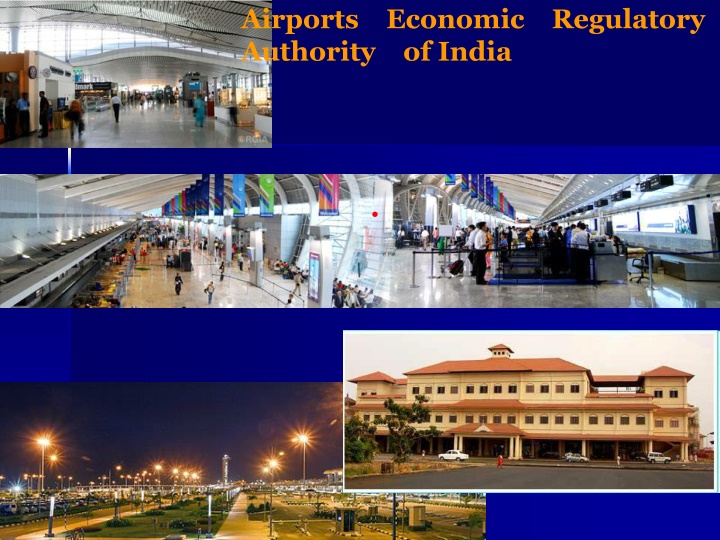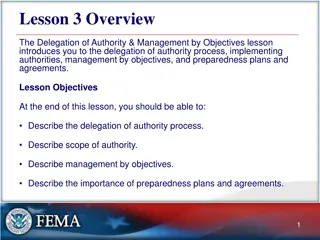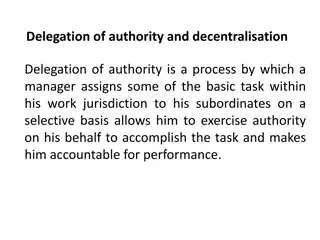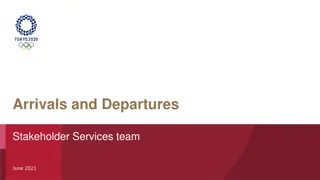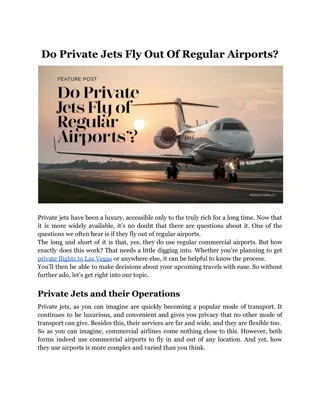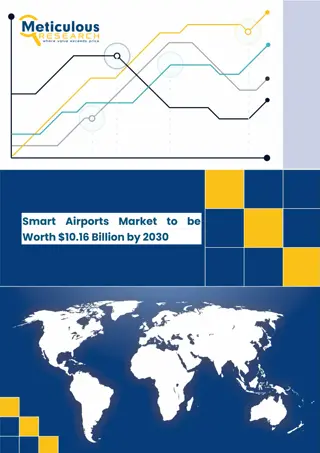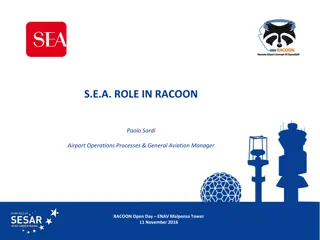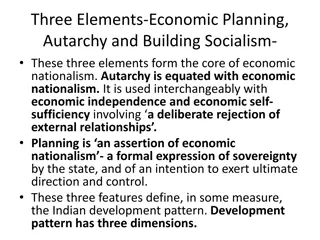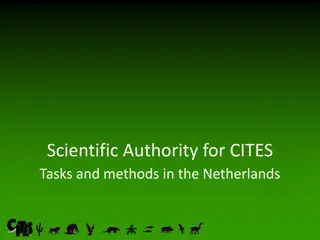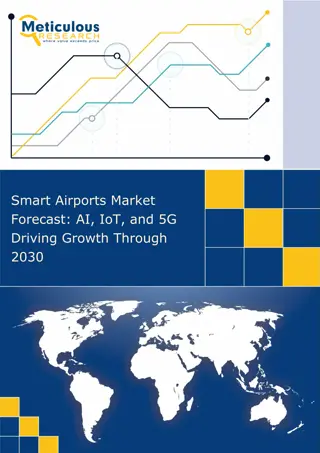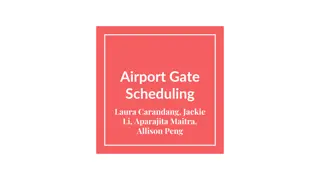Airports Economic Regulatory Authority of India - Regulatory Overview
The Airports Economic Regulatory Authority of India (AERA), established in 2009, regulates major airports to facilitate aviation sector growth, protect user interests, and promote investment. AERA sets tariffs, development fees, and monitors service quality to ensure efficient airport operations. The organization plays a crucial role in maintaining standards and promoting development in the Indian aviation industry.
Uploaded on Sep 30, 2024 | 2 Views
Download Presentation

Please find below an Image/Link to download the presentation.
The content on the website is provided AS IS for your information and personal use only. It may not be sold, licensed, or shared on other websites without obtaining consent from the author.If you encounter any issues during the download, it is possible that the publisher has removed the file from their server.
You are allowed to download the files provided on this website for personal or commercial use, subject to the condition that they are used lawfully. All files are the property of their respective owners.
The content on the website is provided AS IS for your information and personal use only. It may not be sold, licensed, or shared on other websites without obtaining consent from the author.
E N D
Presentation Transcript
Airports Economic Regulatory Authority of India .
INTRODUCTION Airports public sector monopoly till 2003. Unprecedented growth in air traffic led to considerable strain on airport infrastructure (2004-05 to 2007-08) 30% groowth in domestic traffic and 15% in international 2000-2010: Indian aviation had to cope with an additional 84m PAX. Need for attracting private investment to create world class infrastructure: -Govt permitted private sector in airport development in 2003-04. -In 2006, Delhi and Mumbai Airports leased out to GMR Group and GVK Group respectively. JVCs were formed.
INTRODUCTION (Contd ) OMDA and State Support Agreement (SSA) were signed with JVCs SSA indicated Govt intention to establish independent regulator AERA Act, 2008 was enacted for economic regulation of airports with effect from 1.1.2009.
INTRODUCTION (Contd ) AERA Act applies to all major airports other than airports and airfields belonging to or subject to control of the Armed forces or paramilitary forces of the Union. A major airport which handles or is designed to handle more than 1.5mln passengers in ayear Govt may notify any airport as a major airport There are 24 major airports as on 1.1.2017
Organizational Structure Chairperson Member Member Secretary OSD (Tariff) Deputy Chief Under Secretary (P & A) Under Secretary (F & A) AGM (Fin.) AGM (Fin.)
Regulatory Objectives Facilitating wider policy aims for the aviation sector through regulation of major airports, recognising their role in the sector and economy; Protecting and promoting interests of existing and future users of major airports and air navigation services through provision commensurate with the respective charges, keeping in particular focus the interests of passengers and cargo facility users and the user expectations; of quality services Promoting investment in airports and air navigation services and their effective management so that all reasonable demands for airport services are met efficiently.
Main Functions of AERA Determine tariffs for the aeronautical services. Determine amount of Development Fees. Determine amount of Passenger Service Fee. Monitor the set performance standards relating to quality, continuity and reliability of the service at the airport.
Aeronautical Services and AERAs Approach To Economic Regulation Aeronautical Services are as given below: Services provided by the airport operators (Airport Services) Air Navigation Services (ANS) AAI Cargo Facility, Ground Handling & Supply of Fuel to an aircraft Regulatory approach for tariff determination: Price cap Model Light touch approach
Airport Charges Airline charges Landing, Parking, Housing Charges. Navigation charges (RNFC, TNLC) Passenger charges UDF ADF Cargo Charges Fuel Supply Ground Handling
Factors affecting tariff determination Capital expenditure incurred and timely investment in improvement of airport facilities; Services provided, its quality and other relevant factors; Cost for improving efficiency; Economic and viable operation of major airports; Revenue received from aeronautical services; Concession offered by the Central Government in any agreement or memorandum otherwise; Any other factor which may be relevant for the purposes of this Act. (i) (ii) (iii) (iv) services other than the (v) (vi) of understanding or (vii)
Procedure to Determine Tariffs Determine tariff once in five years - Amend in public interest during the said period of five years Transparent process - Consultation with stakeholders. -stakeholders make submissions to AERA -all decisions of AERA fully transparent, documented & explained. Airport operators, Indian representative bodies of the airlines and airports, Cargo facility user, Central Government, respective State Governments and consumer organizations consulted on a regular basis by the Authority. registered airlines,
Regulatory Building Block Approach Price Cap Regulation Single Till CAPEX Fair Rate of Return: WACC RETURN ON RAB REGULATORY ASSET BASE (RAB) Non- aero revenue Revenue Requirement Traffic OPEX +TAX DEPRECIATION Aeronautical Yield per Passenger Service Quality Annual Tariff Proposals
Appeal Process First Appeal: AERA Appellate Tribunal Second appeal: Supreme Court
Regulatory Asset Base Consists of only aeronautical assets. Common area in Terminal building is classified into aeronautical, non aeronautical. Normative cost prescribed for runway, apron and terminal building
DEPRECIATION Companies Act rates are followed for standard assets Runway, Apron and Taxiways AERA will prescribe based on a study
Weighted Average Cost of Capital Cost of Equity 16% Study by NIPFP Cost of debt Normative debt equity not prescribed
Operation and Maintenance Expenditure Efficient O&M Expenses to be included O&M Expre to be allocated- aero & non- aero based on certain criteria
Non Aeronautical Revenue Major non-aero revenues Duty free Retail Food & Beverages Car park Advertisements
TILL Single Till- All non-aero revenues used to subsidise aeronautical charges: Dual Till - Non-aero revenues not taken into consideration Hybrid Till- Portion of non-aero revenues taken as subsidy
Taxation Taxes paid on aeronautical revenue are returned to the airport operator.
Annual Revenue Requirement ARR= RAB*WACC+D+O+T-NAR RAB-Regulatory Asset Base, WACC- Weighted Average Cost of Capital, D- Depreciation, O- O&M Expre, T- Tax and NAR is Non-Aero Revenue
X Factor PV of five years ARR is equated to the PV of expected revenue at the current airport charges to arrive at the X Factor.
Yield Per Passenger Maximum Allowable Yield per Passenger PV of Aggregate ARR divided by estimated passenger throughput.
Tariff Card Airport Operator submits tariff card. AERA checks to see that tariff as proposed earns the operator a sum equivalent to the ARR
CGF and Light Touch Regulation Cargo, Ground Handling and Fuel Farm Operations Fixed on light touch if the service is not material, or if material it is competitive and if material and not competitive, based on User agreements
Recent Developments National Civil Aviation Policy-2016(NCAP-2016)-The NCAP-2016 has been approved by the Govt. Para 12(C) of the NCAP-2016 has envisaged changed in the till regime from Single Till to Hybrid Till . Under Hybrid Till 30% of the Non- aeronautical Revenue shall be used to cross subsidize the aeronautical tariffs . Para 19(a) of the NCAP-2016 has recommended for minimum 3 ground handlers instead of 2 as the criteria for competition assessment . Normative Approach: AERA has issued Order No. 07/2016-17 dated 13.06.2016 benchmarking the cost for terminal building, runway, taxiway etc.
Orders Issued 7299022357
